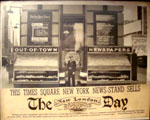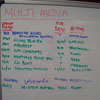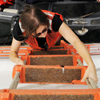Summary
There is a “tsunami going through our industry and all of society,” says Gary Farrugia, publisher of The Day, caused by changes in technology and an “oppressive recession” that has hit, “particularly hard, businesses that rely on advertising as a major source of revenue.”
The recession caused a number of “structural changes,” particularly in The Day’s newsroom. “The world has turned upside down in news,” says Farrugia. In 2001, there were 66 FTEs (full-time equivalents) in the newsroom. In 2010, there were 63 FTEs, but the jobs were vastly different. Now they have, “videographers, video producers, digital directors, and breaking news editors,” says Farrugia. “It’s about eyeballs” now, he says.
These changes required a “deconstruction” of the traditional news and copy desk. When Executive Editor, Timothy Dwyer, joined The Day in 2007 he analyzed whether the newsroom had the “infrastructure and attitude” needed for a digital transformation. With the help of newsroom managers, he decided to “build the perfect newsroom” with an emphasis on local news, watchdog journalism and online infrastructure. They identified the skills and jobs needed and then determined which staff members could fill those jobs. They came up with 15-20 more jobs than people, which caused them to prioritize coverage. The Day “dismantled the features staff,” making everyone features writers, which Dwyer acknowledges was a weakness in the plan, so The Day is finding ways to rectify it.
These changes paid off for The Day. The New England Newspaper & Press Association (NENPA) named The Day “Newspaper of the Year” in its circulation category for both Daily and Sunday in 2010. Theday.com was voted New England’s best news website by NENPA in both 2009 and 2010, and in 2009 Editor & Publisher cited theday.com as one of the top three newspaper websites in the country with 1 million unique visitors or fewer per month. (See the Backgrounder for details on the digital operation and Enterprise Stories for examples of multi-media storytelling.)
Daniel Williams, Director of Audience Development, imagines a 5-to-10 year transition at The Day from print to offering a “digital content distribution hub” for readers paid for through a “membership model,” providing readers access to content from all sources The Day publishes.
Check This
Farrugia discusses changes in advertising and circulation, and Dwyer gives examples of how The Day manages “perceived conflicts of interest” and other ethical issues in the newsroom. Be sure to click on J-Epiphanies to hear Farrugia, Dwyer, and Williams relate an anecdote about when the power and purpose of journalism became clear to them.
The Day is a for-profit newspaper owned by a non-profit. “The Day Publishing Company is owned by a split-interest trust, which devotes its attention to operating the newspaper and supporting a charitable foundation, the Bodenwein Public Benevolent Foundation. This arrangement ensures that the newspaper will remain independent and locally owned and that profits from the newspaper will be distributed to non-profit organizations within The Day's primary circulation area.” (The Day is one of several newspapers owned by non-profits participating in the WNN report: The Columbia Missourian, The Delaware State News, St. Petersburg Times, and Northeast Mississippi Daily Journal).
Coming next in the New England series: The Providence (R.I.) Journal
Followed by the Mid-Atlantic series: The (N.J.) Record, Delaware State News, and The (Md.) Afro-American.
-- Sara Brown and Paul Steinle














